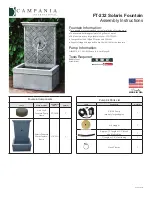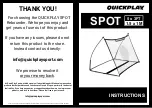
4
FREQUENTLY ASKED QUESTIONS
Q.
How long will it take to assemble the building?
A.
Assembly time depends on a variety of factors, including roof design, tools available, DIY skill and the pace
at which you work. Guidelines for each shed assembly are approximate AFTER completion of the base, and
assume two or more people working on the assembly. Generally, you should plan on at least one day working with
someone who can assist you; again, after constructing the base. Refer to the clock icons on each product page
on the website for specifi c time estimates.
Q .
How do I decide where to put my shed?
A.
The key to a successful assembly is to make sure the shed will be square and level when built. The shed can
be assembled directly onto level ground (grass or dirt). If you have location options, choose one that is already
fl at, with good drainage to control moisture. If you don’t have a fl at, well-drained area, you need to prepare the
space. Level the area using cinder blocks, concrete, crushed gravel or other sturdy materials. Once level with good
drainage, construct your base. Using a carpenter’s level, make sure your base is level and free of bumps or ridges
to provide good support for your building.
Q.
What if I can’t fi nish my building in one session?
A.
If weather conditions change so that it becomes windy or rainy, it is recommended that you stop assembly until
conditions improve. This is for your safety and for protection of the shed. However, do not leave your unfi nished
construction without fi rst temporarily anchoring the walls of the shed and placing weights, such as patio blocks or
sandbags, around the walls. Failure to anchor the building if you leave it while partially assembled could result in
irreparable damage or personal injury if the building collapses.
Q.
Do I need to anchor my building?
A.
Yes! Fully assembled buildings should be anchored using a permanent anchoring system. If you need to leave
your building before it is completely assembled, you will need to place weights, such as patio blocks or sandbags,
around the fl oor channel.
Q.
How do I temporarily anchor my building before it’s fully assembled?
A.
An incomplete building must be anchored before breaking for any period of time to prevent possible damage.
•If the building is on a wood base, secure the frame with wood screws in the corners
•If the building is on a concrete base, temporarily anchor the frame in the corners
•Use patio blocks or sandbags along side of the fl oor channel as weights
•Secure the fl oor channel to the ground with ground augers or rope the frame in the corners to the ground
Q.
How do I control condensation and prevent water from leaking in?
A.
To minimize condensation, install a continuous, unbroken plastic vapor barrier with a thickness of 6 mil. between
exposed ground surface and the building’s base. Make sure that washers are used throughout the assembly
process. Ensure that all washers are fl ush with the panels and do not over-tighten screws, as this can crack the
washers. Silicone caulking may be used to create watertight seals at the washers and throughout the building.
04BA
Summary of Contents for EZEE SHED EZ8772HVCC
Page 13: ...12 ASSEMBLY OVERVIEW 12CR 2 3 1 6 4 5...
Page 14: ...13 ASSEMBLY OVERVIEW 13CR 9 10 7 8...
Page 18: ...17 Step 1 Side Walls 2X 17CR 11000 You will need for this page QTY 8 10999 A A A A A...
Page 40: ...39 Step 7 Wall Assembly 39CR You will need for this page QTY 12...
Page 50: ...ASSEMBLY NOTES 46A 49...
Page 51: ...ASSEMBLY NOTES 46A 50...
Page 52: ......






































